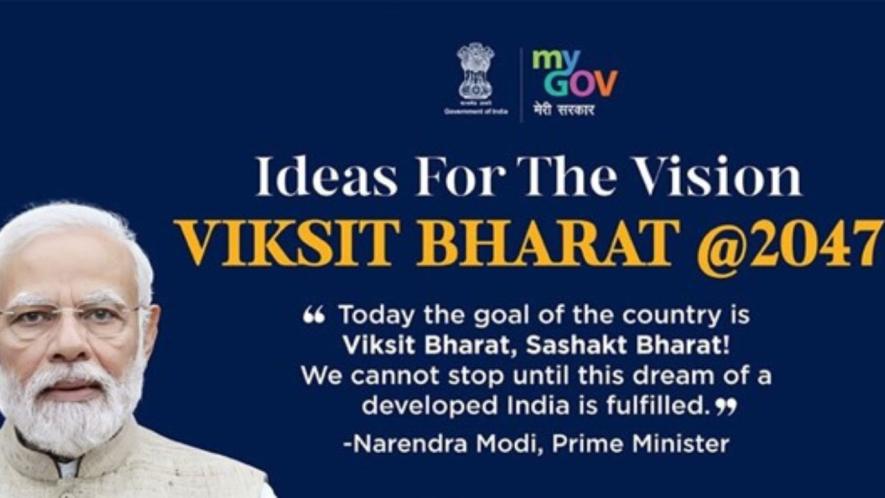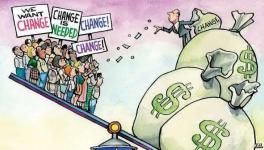Viksit Bharat@2047- Utopia or Doable?

Image Courtesy: School of Online Education
In 1963, at the “March of Washington”, Martin Luther King gave his famous “ I Have a Dream” speech in which he recalled the promise that architects of US constitution had made- “that all men—yes, black men as well as white men—would be guaranteed the unalienable rights of life, liberty and the pursuit of happiness”. The architects of Indian constitution had also promised to all Indian citizens that the republic would secure to all its citizens – Justice (social, economic and political), Liberty, Equality, and Fraternity. After 75 years of independence, it is observed that instead of making an unbiased assessment of the progress made in fulfilling these commitments. the governing elite of the country is focussed on spinning of a new dream- that is of Viksit Bharat@2047. It is being claimed that India has stepped into a period of golden age, called Amritkal, or the “ Era of elixir”. By 2047, it is predicted that India will become a “Developed “or Viksit economy. According to the Hindu mythology, Amrit, the elixir of immortality, was churned out from the depth of ocean of milk by the combined effort of Devas (Gods) and Asuras (demons). In today’s India, where one’s adherence to traditional values and social norms define his or her position within the extant political spectrum, assignment of the labels of Devas and Asuras to anyone would also depend on that position.
However, whether such predictions are based concrete foundation or are merely optimistic projections influenced by various factors including political, economic, and social agendas, is subject to debate. Confucius’ wisdom offers a cautionary reminder that success isn’t merely a result of lofty aspirations; it requires meticulous preparation and groundwork. Setting ambitious goals is undoubtedly important, but without the necessary groundwork, these aspirations may remain unfulfilled. Confucius warns against the danger of indulging in mere wishful thinking, likening it to the creation of a utopia that lacks substance.
“Success depends upon previous preparation, and without such preparation, there is sure to be failure.” – Confucious
The ongoing narrative surrounding India’s aim to become a “Developed” or “Viksit” economy by 2047 overlooks a critical aspect. It is not the size of an economy that is used by the UN or World Bank for classification of a country on the scale of development. The per capita Gross National Income (GNI) is often considered a more accurate indicator of development. For any nation, if development does not significantly change the quality of life of an average citizen, then the nation cannot qualify to be called a developed country.
For the year 2022, the World Bank has defined low-income economies as those with a GNI per capita US$1,135 or less ; lower middle-income economies are those with a GNI per capita between $1,136 and $4,465; upper middle-income economies are those with a GNI per capita between $4,466 and $13,845; high-income economies are those with a GNI per capita of $13,846 or more. Having per capita GNI of USD 2390 in 2022, India still falls into the lower middle-income group. The annualized growth rates required for India to transit from a lower middle-income country to an upper middle-income country and more ambitiously to cross-over to a developed or high-income country are worked out below.
India’s per capita GNI, as computed by the World Bank, has risen from $1590 in the year 2015 to $2390 in the year 2022; that is at the yearly compounded growth rate of 6.0 percent. If this compound growth rate continues, for the next 25 years, India’s per capita GNI should reach around $10450. The lower threshold for inclusion in the middle-income group of countries is expected to reach $6411 by the year 2047, on the assumption that the observed growth rate of the lower threshold of this income group would continue to rise in the same rate as was observed between the year 2015 and 2022. In other words, India is expected to become a middle-income country. But the upper threshold of this income group is expected to rise during the same period to $20086. In other words, India will still be far away from the membership of the high-income group of countries. To be included into the high-income group, India’s per capita GNI must grow by a compound growth rate of 8.89%. Whether achieving such a growth rate is feasible or not is anybody’s guess and outside the purview of this article. However, it is quite possible to examine whether the current political regime can achieve such a growth rate. Towards this end the compounded annual growth of India’s per capita USD GNI during the earlier regime (2004 to 2013) is compared with that of the current regime (2015 to 2022). The respective figures are 10.7% and 5.6%. To gatecrash into the elite club of developed countries, India’s per capita GNI ( in USD) must grow annually, by an average of 9% , till 2047. Since faith can move mountain, devotees are free to bet on the possibility of India becoming a Viksit country by 2047.
Data:Boundaries of per capita GNI (current US $)
https://data.worldbank.org/indicator/NY.GNP.PCAP.CD
https://blogs.worldbank.org/en/opendata/new-country-classifications-2016
Courtesy: Ashok Nag’s blog ‘Thinking Rationally’. The writer is independent consultant on data analysis and risk management.
Get the latest reports & analysis with people's perspective on Protests, movements & deep analytical videos, discussions of the current affairs in your Telegram app. Subscribe to NewsClick's Telegram channel & get Real-Time updates on stories, as they get published on our website.
























